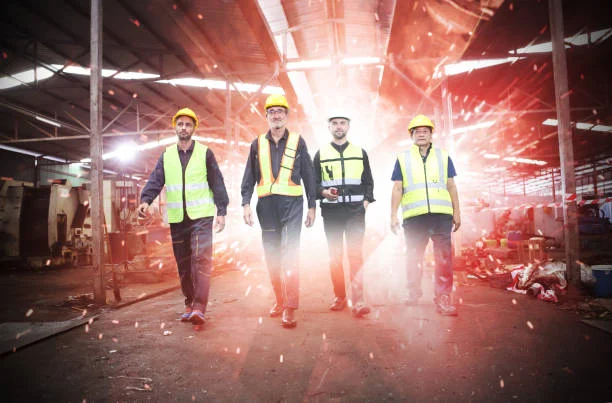Workplace burn accidents are more common than most people think, and Latino workers often face the biggest risks.
Many Latino workers are employed in physically demanding jobs like construction, restaurants, and manufacturing, where exposure to hot surfaces, chemicals, and flames is frequent. Immigrant Hispanics face even more danger due to language barriers and limited access to safety training. These factors, combined with the fear of reporting unsafe conditions, put Latino workers in a particularly vulnerable position for serious injuries.
Curious for more insights? Related Posts are your next stop!
What counts as “workplace burn injuries”?
A “workplace burn” covers a wide variety of injuries occurring at work from sources like heat, flame, hot surfaces or liquids, chemicals, or electricity. Broadly, you’ll see
- Thermal burns: These happen when skin comes in contact with hot surfaces, flames, or boiling liquids. Think about cooking in a restaurant, working near a furnace in a factory, or welding. Even a small splash of hot oil can cause a serious injury.
- Electrical burns: Touching live wires or faulty equipment can cause both shock and burns simultaneously. These burns often affect your hands and arms and can even lead to heart or nerve damage.
- Electrical arc burn injuries: Sometimes it’s not necessary to touch live wires to receive an electric burn. High voltage can jump from two wires that are not touching or through a person who is not touching them. When current passes through the body, or when an arc flash causes extreme heat.
- Chemical burns: Certain cleaners, acids, or industrial chemicals can burn skin on contact. Even if the burn doesn’t hurt immediately, chemicals can continue to damage tissue until properly treated.
- Radiation burns: Prolonged exposure to ultraviolet light, welding arcs, or industrial radiation can damage skin. These aren’t as common, but they can cause serious long-term health issues.
A ten-year study published in the International Wound Journal in 2023 found that 62% of occupational burn accidents involved fire & flames.
How Common Are Workplace Burn Accidents?
Burn injuries at work happen more often than people realize. According to the American Burn Association, there were around 398 000 burn-related injuries and an additional 252 000 accidents involving hot surfaces in the U.S. in 2021.
According to the Bureau of Labor Statistics, in 2020, there was a total of 11 840 heat-provoked burn and 3 540 chemical burn accidents in the U.S. that resulted in days away from work.
Latino workers are particularly affected because many are employed in physically demanding jobs where burns are more likely to happen. Knowing how often these accidents occur can help managers take prevention seriously. A burn accident is not just “bad luck,” it’s the result of a lack of safety measures in the workplace.
Why do Latino workers face higher burn hazards at work?
According to the Center for Economic and Policy Research, Latino workers are more likely to die from a workplace accident than any other ethnic group. Hispanics face higher risks for several reasons:
- High-risk jobs: Many Latino workers are employed in construction, restaurants, manufacturing, or agriculture. These jobs have higher rates of burns and other injuries. Many Hispanics suffer from restaurant and construction burn accidents.
- Language barriers: Safety instructions, labels, and training are often in English or assume a certain literacy/training background. If Spanish isn’t offered, foreign-born workers might not fully understand the risks or procedures. The U.S. Occupational Safety and Health Administration (OSHA) requires employers to ensure training in a language workers understand. When Spanish or bilingual resources are missing, workers may be unaware of burn hazards
- Less training: Some employers give minimal safety instructions, assuming workers “figure it out.” Without proper training, accidents are more likely.
- Fear of speaking up: Some workers avoid reporting hazards because they fear losing their jobs, especially if they are undocumented.
- Lack of Personal Protection Equipment: Some employers or managers who hire Hispanics without legal work permits disregard safety standards, exposing their employees to preventable hazards.
How Managers Can Reduce Workplace Burn Accidents
Workplace safety is the legal responsibility of employers. All employers must ensure their workplace follows OSHA burn protection requirements and local regulations.
1. Strengthen safety systems
Engineering and administrative controls should always come before relying on protective gear. These systems eliminate or reduce burn hazards at the source.
- Isolate hazards: Install shields or barriers around hot machinery, steam lines, and chemical zones.
- Control “hot work” safely: Require hot-work permits for welding, cutting, or brazing, and assign a fire watch for every job (OSHA Standard 1910.252).
- Use lockout/tagout (LOTO): Ensure energy sources are shut off and locked before maintenance (OSHA 1910.147).
- Maintain ventilation: Keep work areas cool and well-ventilated, and plan rest breaks in high-heat environments.
- Inspect equipment regularly: Schedule routine checks for ovens, thermostats, wiring, and electrical tools.
- Label danger zones: Place clear, bilingual warning signs where hot surfaces or chemicals are present.
2. Enforce the proper use of protective gear
Personal Protective Equipment (PPE) is the last line of defense when controls cannot eliminate hazards. Managers must make sure PPE is available, fits properly, and is actually being used.
- Provide flame-resistant clothing, gloves for heat or chemical protection, long sleeves, face shields, and safety goggles as needed.
- Inspect PPE before each shift; replace damaged items immediately.
- Confirm all PPE meets OSHA standards: General PPE, standard number: 1910.132, Eye and Face Protection, standard number: 1910.133, and Hand Protection, standard number: 1910.138.
- Reinforce use during daily check-ins and correct non-compliance quickly but constructively.
3. Deliver training that workers actually understand
Even the best safety policy fails if employees can’t understand or apply it. OSHA requires that all training be provided in a language and vocabulary that workers can understand.
- Offer bilingual or pictogram-based training for workers with limited English.
- Include live demonstrations for tasks with high burn risk, such as welding, fryer operation, or chemical handling.
- Review Safety Data Sheets (SDS) in group briefings and highlight the burn risks of chemicals used that day.
- Conduct short toolbox talks before high-risk shifts and encourage workers to speak up about unclear procedures.
- Teach burn first aid: cool the injury with clean, cool water (not ice) for 15 minutes and seek prompt medical help for serious burns.
<h3> 4. Use a simple daily safety checklist
A short, structured checklist helps supervisors maintain consistency and accountability.
- All guards and shields are secured on hot or electrical equipment.
- PPE is clean, available, and fits every worker.
- Eye-wash stations, emergency showers, and burn kits are stocked and working.
- Hot-work permits are signed; fire-watch is assigned if needed.
- Lockout/tagout procedures verified before maintenance.
5. Prepare for first aid and emergency response
Even with solid prevention, accidents can still occur.
- Keep a stocked first-aid and burn kit in every department.
- Train key staff in burn first aid and emergency communication.
- Establish a clear reporting protocol and make sure everyone knows who to contact.
- Review emergency plans quarterly and after any incident to fix gaps.
Worker rights & employer duties
Managers should be aware that every worker, regardless of immigration status, has fundamental rights on the job.
Key workers’ rights:
- The right to a safe workplace: Employees must have a work environment free from recognized hazards. That includes working equipment, proper PPE, and burn prevention systems that meet OSHA and local standards.
- The right to training and information: Workers have the right to know what chemicals or hot equipment they are exposed to, and how to handle them safely.
- The right to report unsafe conditions: Workers can report hazards or injuries to their employer or OSHA without fear of retaliation. Firing or punishing an employee for raising safety concerns is illegal and can lead to federal penalties.
- The right to medical care after an injury: In states like New York, employers must carry workers’ compensation insurance that covers medical treatment and part of lost wages after a workplace injury, regardless of who was at fault.
- The right to pursue further legal action: If a burn results from negligence, such as ignored safety rules, faulty equipment, or unsafe premises, employees may also have grounds for a separate legal claim.
Can Workers Receive Compensation for a Workplace Burn Injury in New York?
All workers in New York should be covered by Workers’ Compensation Insurance. This insurance covers all injured workers, regardless of who was at fault. This insurance will cover:
- All medical expenses and rehabilitation
- Compensate lost wages
- Provide disability benefits
- Benefits for the family of a deceased worker.
Workers’ Compensation Insurance protects most employers from lawsuits; however, if the injury happened because the employer ignored safety rules or provided unsafe equipment, or a third party was responsible for the accident, workers can seek legal help after a burn injury in NYC to pursue additional compensation.
Conclusion: Know the Hazards and Follow Safety Standards
Workplace burn accidents are a serious concern, particularly in high-risk roles where Latino and other vulnerable workers are overrepresented. Managers have the responsibility to identify hazards, enforce safety protocols, and ensure employees are equipped with the right protective gear. Following OSHA standards, providing proper training, and maintaining safe equipment can prevent most accidents before they occur. If a burn injury does happen, managers must act quickly, provide immediate medical attention, document the incident, and support the worker in understanding their legal rights for Workplace burn accidents. By taking these steps consistently, managers can increase Latino worker safety, create safer workplaces, and significantly reduce preventable burn injuries.
From insights to inspiration—Explore More and keep the ideas rolling at Management Works Media!






